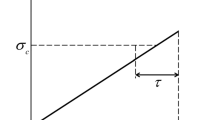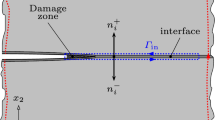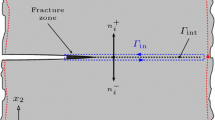Abstract
Dynamic crack propagation of mode-II cracks is simulated using bond-based Peridynamic Theory (PD) implemented in finite element analysis software ABAQUS. The specimen is a bonded homogeneous Homalite plate with a pre-notch that is subjected to impact shear loading simulating the experiments of Rosakis et al. (1999). The PD bonds at the bonding interface are utilized with a scalar critical stretch value that corresponds to mode-II fracture toughness of the interface. The crack initiation and propagation are naturally captured in the bond-based PD simulations by modifying the original prototype microelastic brittle law formulation introduced by Silling and Askari (2005). Impact loading is introduced at the specimen as a pulse speed field boundary condition. Using bond-based PD, sub-Rayleigh and intersonic regimes of crack growth are obtained as a function of fracture toughness (\(G_{II}\)) and impact speed (\(V_i\)) values. The intersonic crack growth is discerned from the sub-Rayleigh crack growth by the existence of shear Mach waves in the particle velocity magnitude contours. For critical values of \(G_{II}\) and \(V_i\), a crack growing at a speed just below the Rayleigh wave speed is observed to transition to an intersonic speed with a Burridge-Andrews mechanism. The sustained intersonic crack tip speed is found to be between \(1.57c_S\) (\(c_S\) is the shear wave speed) and \(c_D\) (\(c_D\) is the dilatational wave speed). For a reduced impact pulse duration, an intersonic crack is found to approach the theoretical value of \(\sqrt{2}c_S\), which, however is not maintained. The results are in qualitative agreement with the experiments of Rosakis et al. (1999) and previous simulations in the literature.

























Similar content being viewed by others
References
Abaqus V (2014) 6.14 documentation. Dassault Syst Simul Corp. 651:2–6
Abraham FF, Gao H (2000) How fast can cracks propagate? Phys Rev Lett 84(14):3113
Agwai A, Guven I, Madenci E (2011) Predicting crack propagation with peridynamics: a comparative study. Int J Fract 171(1):65
Andrews D (1976) Rupture velocity of plane strain shear cracks. J Geophys Res 81(32):5679–5687
Beckmann R, Mella R, Wenman M (2013) Mesh and timestep sensitivity of fracture from thermal strains using peridynamics implemented in abaqus. Comput Methods Appl Mech Eng 263:71–80
Bobaru F, Zhang G (2015) Why do cracks branch? a peridynamic investigation of dynamic brittle fracture. Int J Fract 196(1–2):59–98
Broberg K (1989) The near-tip field at high crack velocities. In: Structural Integrity, Springer, New York, pp 1–13
Broberg KB (1999) Cracks and fracture. Elsevier, Amsterdam
Burridge R, Conn G, Freund L (1979) The stability of a rapid mode II shear crack with finite cohesive traction. J Geophys Res Solid Earth 84(B5):2210–2222
Cheng Z, Liu Y, Zhao J, Feng H, Wu Y (2018) Numerical simulation of crack propagation and branching in functionally graded materials using peridynamic modeling. Eng Fract Mech 191:13–32
Coker D, Rosakis AJ (2001) Experimental observations of intersonic crack growth in asymmetrically loaded unidirectional composite plates. Philos Mag A 81(3):571–595
Daphalapurkar NP, Lu H, Coker D, Komanduri R (2007) Simulation of dynamic crack growth using the generalized interpolation material point (gimp) method. Int J Fract 143(1):79–102
Diyaroglu C, Oterkus E, Oterkus S, Madenci E (2015) Peridynamics for bending of beams and plates with transverse shear deformation. Int J Solids Struct 69:152–168
Du W, Fu X, Sheng Q, Chen J, Du Y, Zhang Z (2020) Study on the failure process of rocks with closed fractures under compressive loading using improved bond-based peridynamics. Eng Fract Mech 240:107315
Freund L (1979) The mechanics of dynamic shear crack propagation. J Geophys Res Solid Earth 84(B5):2199–2209
Freund LB (1998) Dynamic fracture mechanics. Cambridge University Press, Cambridge
Gerstle W, Sau N, Silling S (2005) Peridynamic modeling of plain and reinforced concrete structures. In: SMiRT18: 18th International Conference on Structural Mechanics in Reactor Technology, Beijing
Gerstle W, Sau N, Aguilera E (2007) Micropolar peridynamic modeling of concrete structures. In: Proceedings of the 6th international conference on fracture mechanics of concrete structures
Ghajari M, Iannucci L, Curtis P (2014) A peridynamic material model for the analysis of dynamic crack propagation in orthotropic media. Comput Methods Appl Mech Eng 276:431–452
Ha YD, Bobaru F (2010) Studies of dynamic crack propagation and crack branching with peridynamics. Int J Fract 162(1–2):229–244
Ha YD, Bobaru F (2011) Characteristics of dynamic brittle fracture captured with peridynamics. Eng Fract Mech 78(6):1156–1168
Hu W, Wang Y, Yu J, Yen CF, Bobaru F (2013) Impact damage on a thin glass plate with a thin polycarbonate backing. Int J Impact Eng 62:152–165
Huang X, Bie Z, Wang L, Jin Y, Liu X, Su G, He X (2019) Finite element method of bond-based peridynamics and its abaqus implementation. Eng Fract Mech 206:408–426
Kilic B, Madenci E (2009) Prediction of crack paths in a quenched glass plate by using peridynamic theory. Int J Fract 156(2):165–177
Lambros J, Rosakis AJ (1995) Shear dominated transonic interfacial crack growth in a bimaterial-i experimental observations. J Mech Phys Solids 43(2):169–188
Lee O, Knauss W (1989) Dynamic crack propagation along a weakly bonded plane in a polymer. Exp Mech 29(3):342–345
Liu C, Lambros J, Rosakis AJ (1993) Highly transient elastodynamic crack growth in a bimaterial interface: higher order asymptotic analysis and optical experiments. J Mech Phys Solids 41(12):1887–1954
Macek RW, Silling SA (2007) Peridynamics via finite element analysis. Finite Elem Anal Des 43(15):1169–1178
Mehrmashhadi J, Wang L, Bobaru F (2019) Uncovering the dynamic fracture behavior of pmma with peridynamics: the importance of softening at the crack tip. Eng Fract Mech 219:106617
Needleman A (1999) An analysis of intersonic crack growth under shear loading. J Appl Mech 66:847–857
Nishioka T (1997) Computational dynamic fracture mechanics. Int J Fract 86(1–2):127–159
Ravi-Chandar K, Knauss W (1984) An experimental investigation into dynamic fracture: Iii. on steady-state crack propagation and crack branching. Int J Fract 26(2):141–154
Ren H, Zhuang X, Rabczuk T (2016) A new peridynamic formulation with shear deformation for elastic solid. J Micromech Mol Phys 1(02):1650009
Rosakis A, Samudrala O, Coker D (1999) Cracks faster than the shear wave speed. Science 284(5418):1337–1340
Rosakis AJ (2002) Intersonic shear cracks and fault ruptures. Adv Phys 51(4):1189–1257
Rosakis AJ, Samudrala O, Singh RP, Shukla A (1998) Intersonic crack propagation in bimaterial systems. J Mech Phys Solids 46(10):1789–1814
Samudrala O, Huang Y, Rosakis A (2002) Subsonic and intersonic mode ii crack propagation with a rate-dependent cohesive zone. J Mech Phys Solids 50(6):1231–1268
Sharon E, Fineberg J (1996) Microbranching instability and the dynamic fracture of brittle materials. Phys Rev B 54(10):7128
Silling SA (2000) Reformulation of elasticity theory for discontinuities and long-range forces. J Mech Phys Solids 48(1):175–209
Silling SA, Askari E (2005) A meshfree method based on the peridynamic model of solid mechanics. Comput Struct 83(17–18):1526–1535
Silling SA, Lehoucq RB (2008) Convergence of peridynamics to classical elasticity theory. J Elast 93(1):13
Silling SA, Epton M, Weckner O, Xu J, Askari E (2007) Peridynamic states and constitutive modeling. J Elast 88(2):151–184
Silling SA, Weckner O, Askari E, Bobaru F (2010) Crack nucleation in a peridynamic solid. Int J Fract 162(1–2):219–227
Washabaugh PD, Knauss W (1994) A reconciliation of dynamic crack velocity and Rayleigh wave speed in isotropic brittle solids. Int J Fract 65(2):97–114
Xu XP, Needleman A (1994) Numerical simulations of fast crack growth in brittle solids. J Mech Phys Solids 42(9):1397–1434
Yang Z, Oterkus E, Nguyen CT, Oterkus S (2019) Implementation of peridynamic beam and plate formulations in finite element framework. Contin Mech Thermodyn 31(1):301–315
Yolum U, Güler M (2020) On the peridynamic formulation for an orthotropic mindlin plate under bending. Math Mech Solids 25(2):263–287
Yu C, Pandolfi A, Ortiz M, Coker D, Rosakis A (2002) Three-dimensional modeling of intersonic shear-crack growth in asymmetrically loaded unidirectional composite plates. Int J Solids Struct 39(25):6135–6157
Zhang G, Gazonas GA, Bobaru F (2018) Supershear damage propagation and sub-Rayleigh crack growth from edge-on impact: a peridynamic analysis. Int J Impact Eng 113:73–87
Zhang Y, Qiao P (2019) A new bond failure criterion for ordinary state-based peridynamic mode ii fracture analysis. Int J Fract 215(1–2):105–128
Zhou X, Wang Y, Shou Y, Kou M (2018) A novel conjugated bond linear elastic model in bond-based peridynamics for fracture problems under dynamic loads. Eng Fract Mech 188:151–183
Acknowledgements
We acknowledge the research support for the project funded by The Scientific and Technological Research Council of Turkey (TÜBİTAK) under Grant No. 115M585.
Author information
Authors and Affiliations
Corresponding author
Additional information
Publisher's Note
Springer Nature remains neutral with regard to jurisdictional claims in published maps and institutional affiliations.
Rights and permissions
About this article
Cite this article
Yolum, U., Coker, D. & Güler, M.A. Intersonic shear crack propagation using peridynamic theory. Int J Fract 228, 103–126 (2021). https://doi.org/10.1007/s10704-021-00520-3
Received:
Accepted:
Published:
Issue Date:
DOI: https://doi.org/10.1007/s10704-021-00520-3




